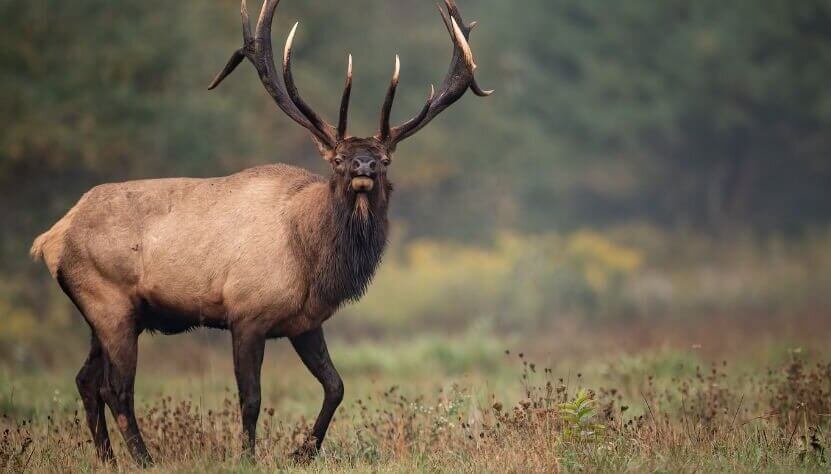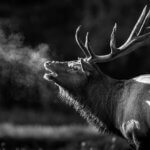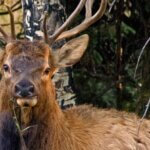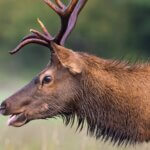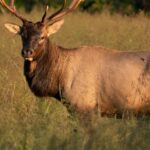Editor’s Note: Eddie Salter of Evergreen, Alabama, is known as Mr. Turkey – a title that speaks to his reputation of having won hundreds of turkey-calling contests and having had so-much success hunting gobblers. He’s also created turkey calls and sold them. Salter’s style of hunting is being aggressive. When he hears a turkey gobble, he wants to go to the tom and get as close as possible before taking him. Salter has learned that being a good turkey caller can make you a good elk hunter. (All artwork this week is courtesy of Dallen Lambson of Pocatello, Idaho, who’s won numerous awards, and has his artwork featured in Bass Pro Shops and Cabela’s stores.
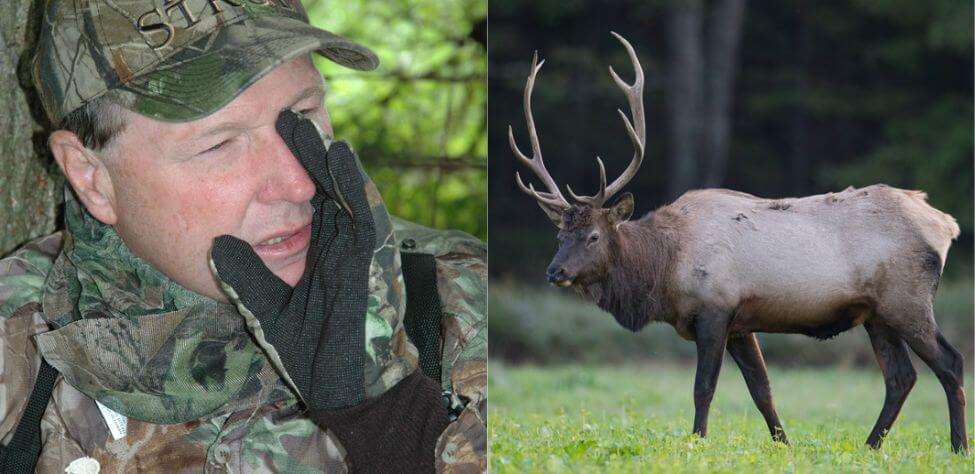
Because my buddy Alex Rutledge of Missouri and I were on the Hunters’ Specialties Pro Staff at the same time, we always had talked about going on an elk hunt together. We had turkey hunted together and called turkeys for each other. We knew Jimmy Hill from Kansas City, Missouri, who was a super-good elk guide, had guided in Colorado and New Mexico. So, another time (see Days 3 & 4) we set-up a hunt with him in New Mexico, again on land that adjoined the Jicarilla Apache Nation Indian Reservation. The reservation homed numbers of older and bigger bull elk than you might see on some private lands and most public lands. Of course, since those bulls couldn’t read property lines, occasionally they’d leave the reservation and head to the property Jimmy had permission to hunt.
Several other hunters were in camp with us, but Alex and I got Jimmy to guide us and call on one day. We decided that whichever one of us had the first shot at an elk, the elk would belong to that hunter. Jimmy was calling for Alex and myself. Alex had much more experience hunting elk than I had. We heard numbers of elk talking that morning but never could work a bull into bow range.
When Jimmy set-up to call, Alex would get 30-50 yards from him on one side, and I’d do the same on the other side. We believed that if an elk did come in, he’d more than likely come in to either side of Jimmy. Whichever one of us saw him first and had him in bow range should try to take him. Jimmy, Alex and I both checked the wind direction each time we set-up to make sure the wind was coming toward us. We also wanted to be close enough to communicate with each other.
Elk aren’t like whitetails in that you may need to chase them. If you don’t call an elk in at first light, he’s probably moved his herd to another spot. If you want to take that bull, you’ll have to follow him wherever he goes and stay far enough away that you don’t spook him or his cows, until they stop and start feeding or return to their beds.
We’d heard plenty of bulls that morning, but when we located this bull, the time was close to the middle of the day. We followed him for about 1/2- to 3/4-mile, until we caught up with him again. We had to go through some tough, rough country to finally get close.
Jimmy called that bull several times when we were following him to hopefully get him to turn away and return to us. When we were about 200 yards from the bull, Jimmy said, “I think this is a good spot for us to set-up and try to get that bull. Eddie, go to the right of me, and Alex to the left. Maybe I’ll be able to hit a call that that bull likes well enough to come back and try to round me up.’ Jimmy used a social bugle, mixed-in with an estrous whine. He told us later that he didn’t like to use a challenge bugle, unless the bull was a good distance from him.
Once you get close to a bull, I’ve learned that you’re better off using the social rather than the challenge bugle. Also, between the bugle and the estrous whine, I’ll use some soft cow calls. When I took this bull, I was leaning next to a tree. Jimmy had been calling the whole time, while I was daydreaming. Suddenly I saw horns coming down through the woods, straight toward me. Immediately, I clipped the release on the string of my bow and put myself in position to take the shot. I got-up on my knees to pull my bow all the way to a full draw without it touching the ground or any of the nearby bushes and small trees.
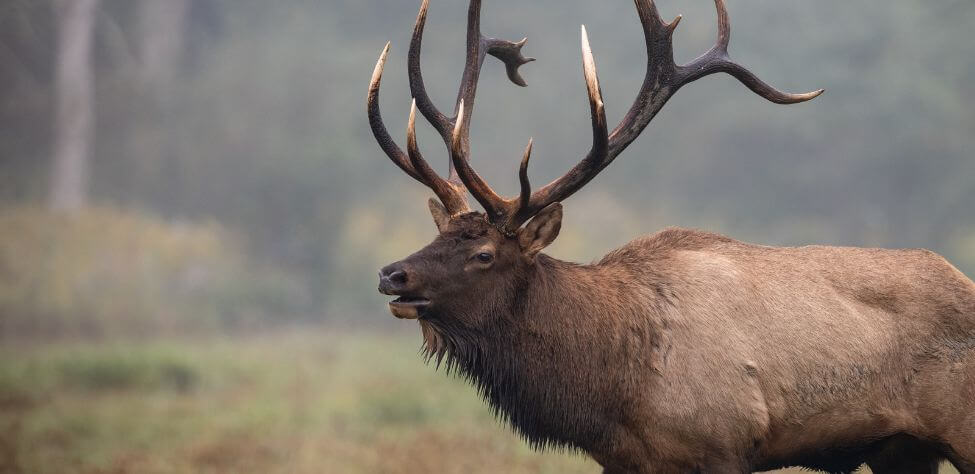
At the time, I was using a Mathews Z7 bow. While I was getting set-up to take the shot, I was looking through several holes in the foliage, hoping that the bull would walk and give me holes to shoot through that wouldn’t interrupt my arrow. Every time I checked that bull, I saw he was coming straight toward me, looking at me, down a trail I hadn’t seen when I’d sat down. He looked straight at me until he was 10-steps away. I kept hoping the bull would turn to the left or right as he moved down the trail, so I would have an opportunity to draw my bow before he got within range.
Finally, the bull turned to my right. I got my bow to a full draw, but even when he stepped into the opening, I couldn’t get a shot off. I was still only 10 steps from the bull and could hear him breathing. Finally, he spotted me and wheeled to his left. I aimed at his lungs when he stepped into one of the openings that I’d hoped he would. But he’d turned so quickly that before the arrow reached him, he’d turned his rear to me. I didn’t learn until later that my broadhead had gone into his hindquarter and severed the main artery of that area. Also, I didn’t realize that when the elk wheeled, he ran in front of Jimmy and Alex, and Alex took a shot at him at 10 or 20 steps. Alex’s arrow hit the bull in the front shoulder area.
When we could no longer see or hear the elk, we went to Jimmy and told him about each of our shots. I was shaking like a leaf in the wind. I’d never been that close to a big bull elk in my lifetime. I had been mainly a turkey and a white-tail deer hunter all my life. Having that bull so close to me was unnerving. Knowing I’d gotten an arrow in him, I shook, shook and shook some more. Jimmy calmed Alex and I down. After looking at the trail the elk had made, Jimmy said, “Eddie, I believe you cut that main artery in the deer’s rump, so we shouldn’t have to go very far before we find him.”
I looked at Alex and said, “If we find this elk, we’ll have to half him up. You get one side of the antlers, I’ll get the other side, and we’ll split-up the meat.” Alex looked at me and said, “No, that’s not going to happen. You hit the elk in a spot that would kill him, and you got the first shot on him. I don’t even know where my arrow hit. I was just helping you out by taking another shot.”
When I mounted the bull elk, I put mine and Alex’s names on the trophy plate. Up until this point, this elk hunt had been fun and exciting. I didn’t realize how much meat was on an elk. The three of us had to make two trips out each to get the head, the hide and the meat transported. We probably went 3/4-mile carrying all the meat and the head back to the vehicle. Alex announced, “Eddie, since we decided that you killed this elk, you have to carry the head out.” That was a big chore. I gave Alex half of the meat.
This bull scored somewhere between 200-290 inches. Even though some elk hunters wouldn’t consider that bull a trophy, he was a trophy for me. We certainly didn’t have any animals that big in Alabama. This hunt I had with Jimmy and Alex made memories of the bull we’d taken, and the success we’d had.
I personally think the trophy is in the eye of the beholder. All three of the bull elk I’ve taken were trophies for me. The bad thing about all three elk adventures was that those bull elk heads in my home burnt-up when my house caught on fire some years ago. My family and I lost everything. However, I still have the memories of these hunts, all I learned about calling elk, and the people who were on the hunts with me. Those memories will last longer than I will.
Expert Guidebooks on Elk Hunting: Best Sellers

Secrets for Hunting Elk
The quickest, easiest (if there is an easy way), and safest way to find and take that bull elk of a lifetime will be to hunt with a guide.
Chad Schearer, a longtime Montana guide and TV personality, told me, “My hunter is my gun. If I get to the elk, and my hunter isn’t with me, then we don’t take the elk. My job is not only to find the elk but also to help the hunter get to the elk and make the experience as enjoyable as I can for him.” That’s the kind of fella with whom I want to go elk hunting.
An elk hunt can be tough, but it doesn’t have to be so tough that you don’t enjoy it. That’s why this elk hunting book starts with the confessions of an elk guide and with Chad Schearer’s philosophy of what the guide and the hunter’s relationship should be.
A good portion of your success will depend on your physical condition, and Matt Morrett of Harrisburg, Pennsylvania explains how an eastern hunter can get ready physically during June and July to hunt western elk, the animals he describes as, “Like deer or turkeys on steroids.”
Wayne Carlton, well-known elk hunter and TV and video personality from Montrose, Colorado, tells us what types of elk calls to use and what to say to the elk. Mike Miller of Colorado, another elk guide and Mossy Oak video personality, has tactics for the best equipment for bowhunting and gun hunting elk.
You’ll learn helpful strategies and hunting tips in this book, as well as some straightforward hunting methods that will help to make your elk hunt more successful.
“Thanks to the advice in your elk hunting books, I was able to call up a nice 6-point (6X6) bull elk! He was bugling like crazy. I called him in from about a ¼ mile away. Called him into bow range (about 40 yards away). It was a thrill!” ~Rob Brannon
VERSIONS: AUDIBLE & KINDLE

Elk: Keys to 25 Hunters’ Success
Often just one tip or tactic makes the difference in whether you take an elk home to dinner or have to hike back to the truck by yourself. In John E. Phillips’ latest elk book, Elk: Keys to 25 Hunters’ Success, you’ll learn from successful elk hunters the strategies they use to find and take elk.
Many know that the technique that seems to work most often is to hunt where other elk hunters don’t and understand where the elk are before you go on a hunt by studying data from each state, visiting HuntData (see chapter 1), examining maps, and reading postings on elk forums.
This book also tells you how to get ready physically for an elk hunt, including participating in Train to Hunt Competitions, what gear you need to take, how to enjoy a successful do-it-yourself elk hunt, or how to pick the best elk guide for you. You’ll also hear about the X System and the Broken Y System of hunting elk.
Although no one person has all the answers on how to help you find and take your elk, I’m convinced that this book’s outdoors men and women will teach you how to have satisfying elk hunts.
As my friend Karl Badger once told me, “Elk hunting doesn’t get any better than when I ride horses into the high backcountry, see two grizzly bears, hear a pack of wolves howl close to camp all night long, eat plenty of delicious food prepared on a fire and enjoy the company of good friends.”
VERSIONS: AUDIBLE, KINDLE & PRINT

How to Find Your Elk and Get Him in Close will teach you the tactics of 10 nationally known elk hunters, to help put that giant bull that’s been screaming at you from afar, in your lap. You’ll learn what some of the best guides, outfitters, and successful elk hunters do to find elk and get them in really close.
Also in this audiobook, you’ll notice that the majority of the experts call elk to within bow range. We selected numerous bowhunters and bowhunting guides, since the bowhunter has to get much closer to a bull than the gun hunter does – often less than 20 or 30 yards – practically in your lap.
On one elk hunt, I’d heard this bull bugle all morning. My guide had called him within 30 yards, and he was standing just inside black timber. I saw the smoke from his nose wafting out into the icy air less than 30-yards away. All the bull had to do was step out, and I could take the shot with my bow. But then, through no fault of my guide or me, the bull vanished.
The only conclusion I could come up with to understand why the bull I wanted to take with my bow hadn’t stepped out and given me a shot, was because he got raptured. He evidently had left the earth with no trace of himself.
This hunt was when I started wanting to learn more about hunting elk up close. In this book, I’ve tried to find some of the most knowledgeable, experienced, and practical elk hunters. I’ve always found that the best way to learn any outdoor skill, is to either hunt or fish with the best sportsmen in that field.
Often, in elk hunting, that means elk guides, who generally hunt every day of the season and receive a salary for every hunter they guide. So, I’ve put together a group of some of the best elk hunters I know to help us all learn how to find bull elk and get them in close.
VERSIONS: AUDIBLE, KINDLE & PRINT



